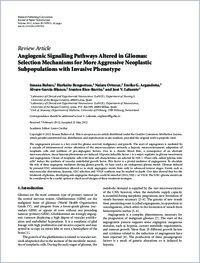Angiogenic signalling pathways altered in gliomas: selection mechanisms for more aggressive neoplastic subpopulations with invasive phenotype
- Bulnes, Susana Laboratory of Clinical and Experimental Neuroscience (LaNCE), Department of Nursing I, University of the Basque Country, Leioa, Spain
- Bengoetxea, Harkaitz Laboratory of Clinical and Experimental Neuroscience (LaNCE), Department of Neuroscience, University of the Basque Country, Bilbao, Spain
- Ortuzar, Naiara Laboratory of Clinical and Experimental Neuroscience (LaNCE), Department of Neuroscience, University of the Basque Country, Bilbao, Spain
- Argandoña, Enrike G. Unit of Anatomy, Department of Medicine, University of Fribourg, Switzerland
- Garcia-Blanco, Álvaro Laboratory of Clinical and Experimental Neuroscience (LaNCE), Department of Neuroscience, University of the Basque Country, Bilbao, Spain
- Rico-Barrio, Irantzu Laboratory of Clinical and Experimental Neuroscience (LaNCE), Department of Neuroscience, University of the Basque Country, Bilbao, Spain
- Lafuente, José Vicente Laboratory of Clinical and Experimental Neuroscience (LaNCE), Department of Neuroscience, University of the Basque Country, Bilbao, Spain
-
22.05.2012
Published in:
- Journal of Signal Transduction. - 2012, p. 597915
English
The angiogenesis process is a key event for glioma survival, malignancy and growth. The start of angiogenesis is mediated by a cascade of intratumoural events: alteration of the microvasculature network; a hypoxic microenvironment; adaptation of neoplastic cells and synthesis of pro-angiogenic factors. Due to a chaotic blood flow, a consequence of an aberrant microvasculature, tissue hypoxia phenomena are induced. Hypoxia inducible factor 1 is a major regulator in glioma invasiveness and angiogenesis. Clones of neoplastic cells with stem cell characteristics are selected by HIF-1. These cells, called “glioma stem cells” induce the synthesis of vascular endothelial growth factor. This factor is a pivotal mediator of angiogenesis. To elucidate the role of these angiogenic mediators during glioma growth, we have used a rat endogenous glioma model. Gliomas induced by prenatal ENU administration allowed us to study angiogenic events from early to advanced tumour stages. Events such as microvascular aberrations, hypoxia, GSC selection and VEGF synthesis may be studied in depth. Our data showed that for the treatment of gliomas, developing anti-angiogenic therapies could be aimed at GSCs, HIF-1 or VEGF. The ENU-glioma model can be considered to be a useful option to check novel designs of these treatment strategies.
- Faculty
- Faculté des sciences et de médecine
- Department
- Département de Médecine
- Language
-
- English
- Classification
- Biological sciences
- License
- License undefined
- Identifiers
-
- RERO DOC 29728
- DOI 10.1155/2012/597915
- Persistent URL
- https://folia.unifr.ch/unifr/documents/302543
Statistics
Document views: 82
File downloads:
- arg_asp.pdf: 135
